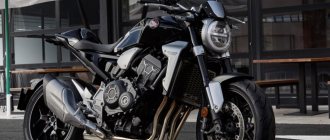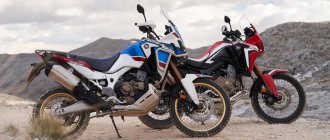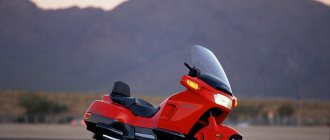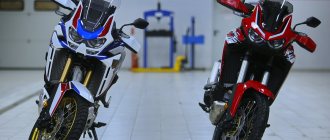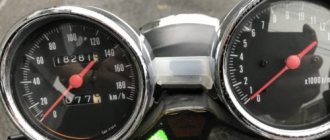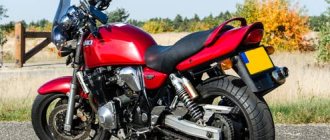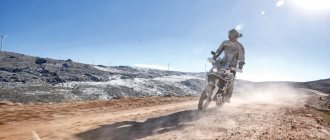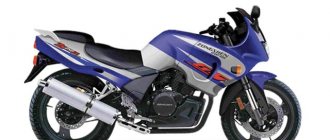I've already watched dozens of hours of videos on Youtube, read megabytes of reviews, spent many hours of sleep at night, weighed hundreds of pros and cons, and now I'm looking at it - the new CB1000R - in the Honda showroom in Nicosia, Cyprus.
Ilya Remizov
Honda CB1000R Neo Sports Cafe Price: from 1,121,000 rub. On sale: from 2021
In person, the new Honda CB1000R is not at all like in the photo - collected, muscular, with a tail cropped like a bull terrier and a wide radiator chest. It's smaller than I expected and the riding position is surprisingly sporty. The high seat and high pegs with long “pins” force you to keep your legs bent, but the back is not loaded as much as on sports bikes. The pose is energetic, with a slight forward bend. Comfortable for my 181 cm height.
After a couple of hundred kilometers I begin to get used to the new motorcycle and pay attention to the details. Idle speed is higher than usual and amounts to 1200 min-1. The moment feels like it is divided into two zones: from idle to 6000 rpm, the traction is smooth and calm, “electric”, but after 6000 and before the cutoff at 11,500, the beast wakes up, which, even in the middle position of the traction control, is able to climb onto the rear wheel with throttle handles. By the way, the electronic throttle on this Honda bike was a great success: the effort is understandable, the reaction is instantaneous.
The first maintenance has been completed, the routine running-in for 1000 km has been completed, the thoroughbred standard Dunlop D214G tires with adult dimensions of 120 mm in the front and 190 mm in the rear have acquired the necessary roughness, you can safely test the capabilities of the “Sibihi” on the winding mountain roads of Cyprus. I lower the tire pressure and move on.
Second gear, 80 km/h, closed left, through the noise of the wind, the bass voice of the exhaust bursts into the helmet. I am pressed into the seat by centrifugal force, and the steering wheel without damping spacers transmits the slightest tremor of the front wheel and allows me to instantly, literally in microns, correct the course. Cafe racer? Well, no, this is Neo, a completely different color. The steering is sharp and easy: the fork angle of 25°, the trail of 100 mm and the high center of gravity make turns and shifts simple and fast - “chicken stripes” disappear instantly.
I have a Honda CB1000R in the “plus” version, which is not yet available on the Russian market. It differs from the standard one in one available color this year - black metallic, a quickshifter that works when shifting both up and down, a protective radiator grille, additional decorative elements made of satin aluminum, single-seat version (passenger seat included, it can be installed), “ fly swatter" (flyscreen - mini fairing) above the headlight and heated handles.
Despite the lack of wind protection, thanks to this mini windbreaker you can maintain a cruising speed of 140 km/h without worrying about your neck. But the motorcycle is not intended for devouring kilometers for many hours: periodic trips from Limassol to Paphos with a total length of about 130 km do not bring pleasure, the bike asks for serpentines, straight roads are not for it. At the same time, the CB1000R feels great in city mode with frequent stops and starts, when driving at low revs and ultra-low speeds - thanks to the informative rear brake and clutch. Large steering angles (hello to the Italian “monsters”) make maneuvering easier. The mirrors do not protrude beyond the handles, which, on the one hand, is convenient when driving between cars, and on the other hand, limits the view to the rear - a third, if not half, of the mirror area is occupied by my shoulders.
By choosing the minimum engine braking mode, you can feel like driving a two-stroke!
The brakes correspond to the nature and power supply of the device. The front Tokico radials have four pistons on each of two 310 mm discs, the rear is a two-piston with one 256 mm disc. Honda has traditionally left the option of replacing rubber brake hoses with reinforced ones on your own, but I didn’t have the desire to do this right away - the brakes are excellent. An interesting feature when braking: if the deceleration exceeds a certain threshold, then even without the ABS triggering, the bike turns on the emergency lights to warn those driving behind. ABS, when it works, does it very softly, without any noticeable kicks to the arm or leg. As I understand it, there is no proprietary combined braking system on this Seabee: I couldn’t find any mention of it anywhere, and when braking with the rear, I didn’t feel the characteristic compression of the front fork.
Pendants require separate words. For my 95 kg, the rear one is frankly soft, and there are not enough adjustments - there is no compression setting. As soon as rear shock absorbers with all adjustments appear on the market, I will immediately upgrade them. Now, if you encounter a pothole or a wave on the asphalt while turning, you can feel the rear pendulum making an extra swing. There are no questions about the front fork: it is fully adjustable, and there is enough range for my weight and riding style. In general, the motorcycle behaves stable at speed, does not notice major flaws, but transfers all the little things to the steering wheel and footpegs.
The new dashboard is easy to read both in the dark and in direct sunlight. It has a built-in light sensor that regulates the backlight and inversion of the LCD panel. I recommend immediately sticking a protective film on it (you survived!) - the transparent plastic is quite soft and after the first wash it becomes covered with small scratches that are visible in the light.
One of the tidy features is a multifunctional light indicator on the top right. It's bright, can glow in different colors, and is customizable. I configured it like this: blue and green for the flow meter (green - very economical, blue - almost economical), yellow to indicate the need to refuel, white as a blinker for upshifting at certain speeds (the speed is also adjustable).
The tachometer is framed by the indicator of the selected gear, it is easy to read, and I often look at this part of the instrument even after more than 3000 km of driving. The reason is the elasticity of the “liter” inline “four”: it seems that I’m driving, for example, in 3rd gear, but when I look at the instrument panel, it turns out that I’m in 4th gear. Time and time again the supply of thrust and its character misleads me.
The rest of the instrumentation is devoted to the speedometer, statistics, engine temperature in degrees, the selected mode and indicators for power, traction control and engine braking. The device doesn’t connect to a smartphone, but there’s no reason to. ABS is not disabled or adjusted at all. In custom mode, traction control can be controlled by a trigger under the index finger on the left remote control. A long press can turn it off completely, burning rubber and doing wheelies at extreme angles (but I haven't tested it). And again I draw attention to the steering wheel, rigidly mounted on the upper cross-beam, with variable thickness (thicker at the attachment point and thinner at the handles) - it is able to withstand any jerks and forces.
At the end of November, the Greek branch of Keith Cod's California Superbike School came to Cyprus, the training day took place on the Achna track. This was the first time my CB1000R took to the track.
On the track, the bike is peppy - it grips the surface well in turns, and at the exit it strives to rise on the rear wheel. But this is not scary, but rather adds fun. Of course, the CB1000R is not suitable for racing records, but it can “give a light” to weekend riders and show a decent time. It would be a skill!
In three months of regular trips, I covered 3,500 km: the island of Cyprus is not very large, but there are almost no direct roads. The motorcycle continues to give discoveries and leaves no one indifferent: it attracts attention on the streets, arouses the interest of experienced and sophisticated riders, and stands out among modern and not so modern motorcycles. And most importantly, it makes me happy every day and has enormous potential that I have yet to measure and experience. To work, to a short trip, to the track, to the training ground, to the mountains - the new CB1000R can do it all, with every one of its 998 “cubes” correct.
For whom
Here are the main features of the model:
- classic exterior, typical of the brightest bikes in the class;
- very comfortable fit, but only if the rider has a suitable build;
- Driving is comfortable only at low speeds without sudden movements.
Honda CB 1000 is suitable for those who want to have a classic two-wheeled car for leisurely driving. Of course, this already quite old motorcycle is a desirable piece for collectors of the best Japanese technology.
Dimensions and weight
This is a fairly large bike with a very high center of gravity, and therefore requires some physical strength and height to control it. The seat height here is 810 mm, and the wheelbase dimensions are 1535 mm. The motorcycle is 2220 mm long, 785 mm wide, and 1130 mm high. Without fuel, the car weighs 235 kg, and with it - all 260 kg. The tank volume is quite large - 22 liters, however, fuel consumption per hundred kilometers is not small and in fact amounts to 7 liters.
Recall of the Honda CB 1000 (CB1000SF, Big One) motorcycle
An hour after studying the appearance of my “Shiba” I decided to go for a ride. I rolled out this heavyweight, took a breath, started it and drove for the first few meters at idle, gave it a little gas and a pleasant heaviness throughout the body, no wild grabs or wheelies, just a high-speed lift with direct traction. I’m driving and thinking, they scared me like a liter, a hundred mares, I need to have experience. Guys, you need to have an instinct of self-preservation and not become impudent after the first thousand, otherwise a liter will put you in your place. Mot is very kind and sympathetic, he swallows bad coverage and the mistakes of a beginner, but if you make him angry (trying to feint in front of girls) and turn the handle more sharply than necessary, you can get in the ass) at best. In general, I fell in love with him and now I’m as happy as an elephant.
So, I managed to screw it up on the first day by 5 cm, when, out of inexperience, I abruptly dropped the clutch (not on purpose). A couple of times I was driving (don’t drive behind gazelles and similar vans, the visibility should be at least 5 cars ahead), I thought I was driving the car, and blew the rear brake to the limit, but my bike forgave me for that, otherwise I wouldn’t have written this article, but at the very least I would be lying in the hospital, and at the maximum... The engine is a carburetor, it must be warmed up, otherwise it won’t run. The brakes are hard, especially the front ones, so I brake with everything at once, with speed, switch to lower and with both brakes, it took me a while to get used to it, but there’s no other way. Despite the windshield, after 140 it starts to blow away, although my friend gave it 160 without a helmet and said that it didn’t even blow into his eyes (maybe he was showing off, or maybe he praised, x/s, I personally tell my impressions), potholes on the roads to him also no problem, rooted to the spot! The speedometer needle goes down without any problems, in short, I don’t know how much I accelerated it, but it was really scary, the speedometer shows 180 and a couple more divisions, then the limiter stops the needle. This pampering is not on our roads!!! But he doesn’t eat like a child! I was unpleasantly surprised when the odometer showed 243 km (I specially reset the odometer and filled the tank full) but it started to build up and eventually stalled. I drove to the gas station on reserve and filled up with 20 liters. The result is 8.2 liters per 100 km in mixed mode, but you can’t do anything, a liter is a liter, you have to pay for comfort. But I think, if you don’t anneal it, don’t knock the needle, then it will easily get to 6-7 liters per hundred!
By the way, the shock absorbers are cool, impenetrable, 160 kg (two men) pulls with a bang, and even if you grunt on the next bump on our “mirror-smooth” roads, you won’t be able to wait!!!
It takes turns with a bang, without a knee of course, but confidently, but don’t accelerate the current, otherwise it will break, a liter after all! And finally, you only need to turn the throttle when you know what you want from it!
Motsik is very kind, it’s like sitting on grandma’s lap! It forgives mistakes, especially for those “much experienced” like me! He doesn’t tolerate showing off, an acquaintance knocked him down right away, as he wanted to burn rubber, fortunately the arcs were there, so he didn’t lose any sales! My friend, after the ride, said “there’s no highlight, well, he just goes on and on.” For me, this motorcycle is just right, I didn’t make a mistake with either the brand or the volume, the traction is simply locomotive, I started off from the second (first) and didn’t even feel any sales.
Yes, it’s a little heavy, but for the first 2 days, then you get used to it so much that 125s and 250s actually seem like scooters. I don’t advise you to take anyone weighing less than 60 kg, just don’t lift it when you fill it up! I'm 75-80, height 185, not a SchwarzNEGRA of course, but I can lift it normally, that is, without smell from the back :) When you go onto a dirt road, you immediately feel all its weight, but on the road it’s like on a bicycle, and it can start no worse than a sport . The box has nothing to compare it with, I can’t say anything bad about the Yamaha , but a Honda is a Honda , clear and understandable!
In general, a worthy device for a beginner, and also great for an old-timer, especially who doesn’t need 200 km/h in 5 seconds... For long-distance travel it’s just super, 250 km with a cruising speed of 120 km/h (that’s what I have) without even thinking about it, You don’t get tired one bit! In short, 1000 km in 3 days, happy as a giraffe!!!
The motorcycle is heavy, weighs about 250 kg when fueled. At about zero speeds it’s a little hard to steer, so I had to get used to it in the evenings and at night. The weight distribution does not allow you to accidentally skid-170 mm. the wheel just breaks into the axle box (I haven’t tried it on purpose). During emergency braking, the front wheel is blocked and you will not be able to fly over yourself. This is what got me down in the wet weather, when the road was blocked by the idiot. I had to brake to the floor and roll onto my side(((. The speed was low, about 60 km/h, and therefore the damage was minimal. Repairs cost 10,000 rubles and the purchase of arcs at Crazy Iron for 4,200 wooden ones.
In terms of taxiing, apart from the fact that it is a bit heavy at low speeds, everything else is fine. I am 192 cm and 95 kg. He transports all this easily. Seating a passenger is also not a problem. Naturally, a carb bike needs to be warmed up. Then he drives normally, without failures (some complained about them). Maximum speed 180 km/h. It already seems like not enough, but our roads and common sense say that it’s enough. I still can’t afford to install the glass, otherwise it’s already sailing at 130-140. It flutters like a sheet in a hurricane)))).
Fuel consumption??? - how to turn the knob))) - from 6 liters to 10 per hundred. A tank of just over twenty liters is enough.
Okay, I’ve written so much and would write more)))… The main thing is not to overclock the gas on a wet road and not to block the front wheel. On a dry road, even with the skid wheel locked, you won’t fall if there is no sand, pebbles and other rubbish...
I liked the motik. The other day I wanted to sell and take the blackbird, but I won’t do it. The blackbird will wait a little))))
Honda CB1000 is something! I know a lot of people will disagree with me, but I think it's just a cool motorcycle. Of course, every owner believes that his machine is the best. I don’t think so, I just pay tribute to this very good motorcycle in all respects.
However, let's take things in order. What is Honda CB1000 ? It is a water-cooled inline four with a displacement of 998 cc. and a power of 98 horses. My Japanese version seems to me to be slightly stifled in power, but knowledgeable people say that this can be easily fixed by replacing the “brains”. Moreover, the Japanese version has a speed limit of 190 km/h, although this can be eliminated. The European and American versions of this motorcycle are more powerful (which doesn’t hurt), and have a maximum speed of 245 km/h. I don't think that kind of speed is necessary for the naked neoclassic that is the Honda CB1000 , although it can certainly achieve it with ease. Together with Monika, I put the speedometer needle on our SV, but at the same time I had to literally squeeze into the tank. Maybe if there was a front shield it would be different, I don’t know...
The motorcycle is quite heavy - 250 kg. At the same time, it has a fairly high center of gravity, which makes it quite difficult to hold it in a tilted stationary position. In appearance it is simply huge. Although it is smaller the Yamaha XJR1300 , it feels taller, wider, heavier and bulkier. However, on the move it becomes almost unnoticeable. The motorcycle takes turns easily, the slight tilt of the steering wheel makes maneuvering easy and fast. However, on a closed track such as the karting track in Mytishchi, considerable weight and a high center of gravity become noticeable very quickly. After making one or two circles, you begin to get tired. Although the Honda CB1000 handles tight turns with confidence and ease, the weight begins to tire the arms a lot. After all, this is not a sportbike! If you go long distance, this problem becomes invisible.
The motorcycle is very obedient and forgives many of the driver’s mistakes. The power curve is almost linear, which is why many professionals call it boring: you always know exactly how the bike will behave. I drove it in the rain and I have to say that I didn't notice much of a difference in performance. It stands like a glove, and only with sharp braking or switching to lower gears is the rear wheel likely to fall off. In other cases, there is not the slightest fear that the wheels will lose traction.
The brakes are brutal! I can’t say anything good or bad about the rear. They brake as best they can, but it’s better not to overdo it. The weight of the motorcycle is such that it instantly skids if the rear brake is used excessively, but it carries straight, so this is not the most serious problem. The front brake is a powerful double-disc brake that grips smoothly, making braking easy to control, but at the same time strong. I tried to brake sharply at 150 km/h - the effect was amazing. Without losing contact with the road, the motorcycle literally digs into the asphalt. At the same time, it is quite difficult to hold on, since the driver is forcefully pressed into the tank and has to firmly press against the steering wheel so as not to be thrown out. There is a plus to this - during emergency braking, you know for sure that you will stop on time :).
The gearbox deserves special attention: the gears are engaged with a knock, but very smoothly and clearly. Finding neutral is not a problem at all. The gears are arranged, in my opinion, optimally. Regardless of the number of revolutions when upshifting, the engine grabs smoothly, without jerks or dips. It can be cranked up to the redline at 8,500 or switched to 2,000. In any case, there is enough traction for confident and smooth acceleration. I drove in 5th gear at 45 km/h, and there was no feeling that the engine was about to choke. When the throttle was turned sharply, there was a barely noticeable delay, the motorcycle seemed to think what to do, and then began to confidently and smoothly gain momentum until the maximum limited speed of 190 km/h.
It's also very easy to anneal on the spot. Many times, standing at the next traffic light, I effortlessly smoked the rear wheel in both first and second gear. I don’t recommend releasing the front brake at this moment without the skill - the motorcycle stands up like a candle and breaks away - breaks out aggressively! - from the hands. However, it’s not very easy to get out of a place alone - considerable weight takes its toll. However, with two people it’s easy – oh the miracles of weight distribution! – you just have to accelerate slightly, and you’re already riding on the rear wheel, helplessly turning the steering wheel.
The suspension of the motorcycle is soft, comfortable, and does not tire or strain you during daily driving around the city. Small bumps and holes are hidden, but I don’t recommend flying into holes at speed - it breaks the shock absorbers. Also because of this, on high-speed sharp turns there appears a barely noticeable swaying of the motorcycle, as if wobbling. When installing a steering damper, this effect becomes almost invisible.
What else can you say about this motorcycle? Of course, it is not for beginners. It has its own, completely definite character, and in order to ride it safely and get maximum pleasure, you need to get used to it. He consumes little fuel - 6-7 liters per hundred. The location and convenience of instruments and switches is very convenient; you don’t need to get used to them. Everything happens instinctively. Like any other Honda, the Honda CB1000 looks beautiful due to the high-quality drawing and execution of all components and parts. The only drawback is the terrible seat. Well, I don't like it. For a passenger, it’s just right: comfortable, wide, soft, although a little high. The driver's part goes under a fairly high tank, which is why when braking, as well as in the pits, you hit the tank at a certain point. Not very pleasant, I tell you. Otherwise there are no complaints. The motorcycle is cool, strong, obedient, comfortable. In short, for those who like heavy classics.
Go to Honda CB 1000
Check out the test drives:
- Test drive Honda CB 1000 from Motorreview magazine
- Test drive Honda CB 1000 from Motorreview magazine
- Test drive Honda CB 1000 from Raging Biker
Chassis and brakes
The CB 1000 has a duplex frame made of steel. The abundance of metal in the exterior immediately catches the eye. Although this is a classic motorcycle, the wheels are alloy. The steering wheel is very comfortable and has traditional dimensions for this class.
As for the suspension, at the rear there is a pendulum version with a double shock absorber, at the front there is a 43 mm telescopic fork. This is a completely natural solution for the class.
The rear brake is a 276 mm disc with a single-piston caliper, and the front is a pair of 310 mm discs with four-piston calipers. It is these components of the bike’s chassis that react particularly sharply to sudden changes in speed and other sporting habits of the rider.
Specifications of Honda CB1000R Neo Sports Cafe
Dimensions2120x789x1095x830 mmBase1455 mmGround clearance135 mmFuel tank volume16.2 lEngine4‑cylinder, in-line, 4‑stroke, liquid-cooled, injection, 998 cm3, 144/10,500 l. s./min-1, 104/8000 Nm/min-1 Transmissionmech., 6-speed, slipper clutch, chain driveFramesteel, spinalFront suspensioninverted telescopic fork with compression, rebound and spring preload adjustment, 120 mm travelRear suspensionmonoshock with rebound and spring pre-compression adjustment, travel 131 mmFront/rear brakehydraulic, 2 discs / 1 discDry weight212 kgTechnologiesABS, traction control, quickshifter (in the “plus” version), throttle-by-wire, 3 engine operating modes, 3 engine braking force adjustments, 3 traction control operating modes, dashboard brightness sensor, heated grips| A drop of service tar A huge disadvantage of Honda, compared to European manufacturers, is that there is no direct contact with the company, it is very closed, everything is done only through dealers, and they are not always happy to ask questions from owners and are in no hurry to share information. There is also no service documentation for the motorcycle for mere mortals. There is not enough accurate data on suspension travel, their characteristics, and factory shrinkage values (static sag / driver sag) - they would significantly speed up the process of customizing the bike. There is traditionally little open information on the “court” Showa - the same Japanese closedness. There is no central step, and the rear wheel is cantilever mounted. This means that for self-service, you will need a special L-shaped stand or a central lift, which is stuck into the side of the motorcycle and lifts it completely. |


